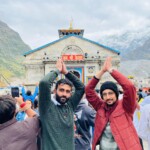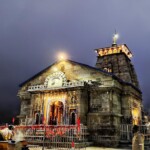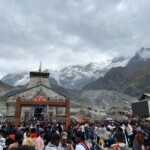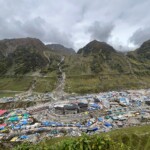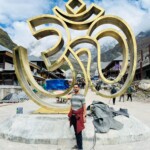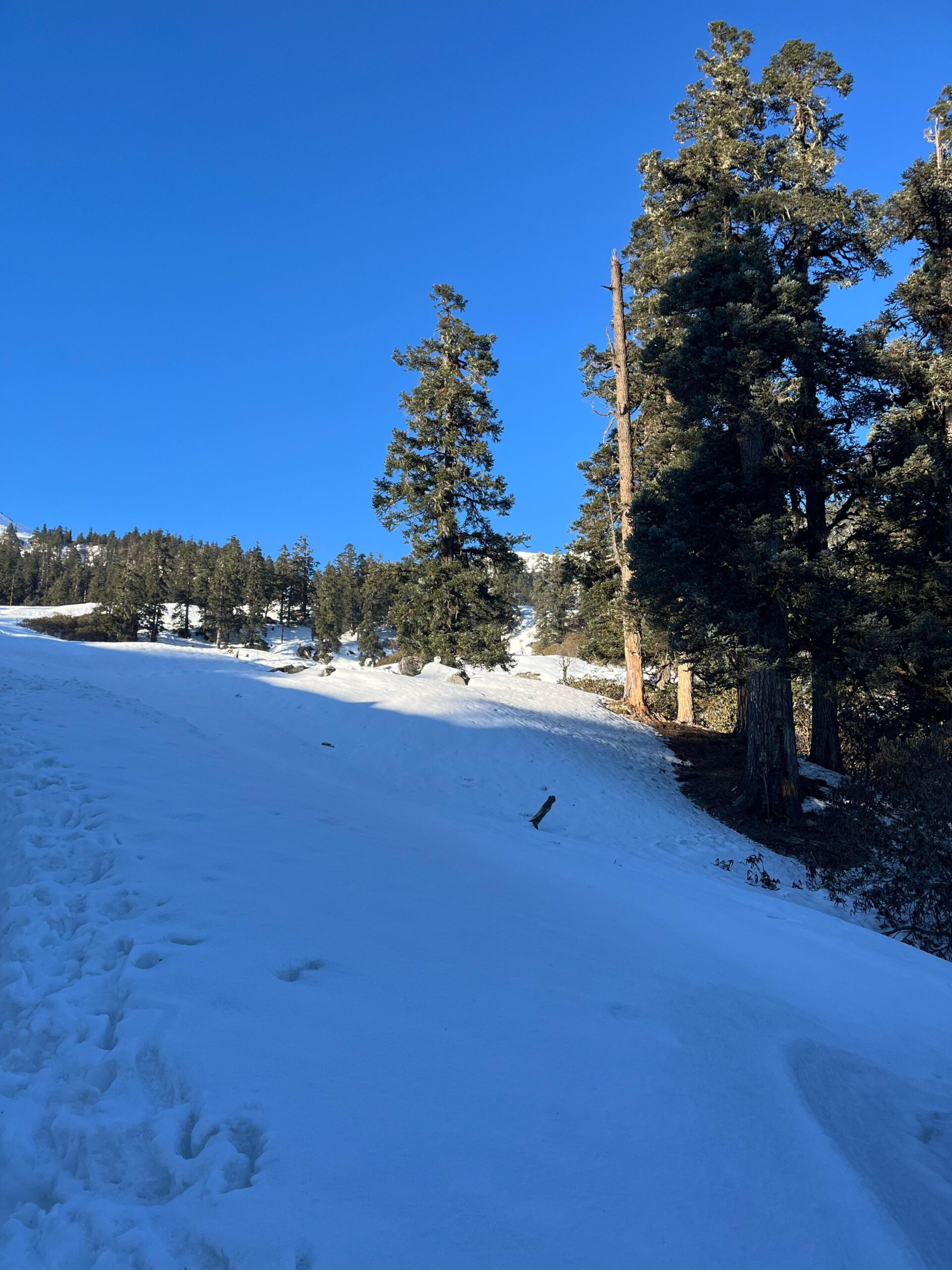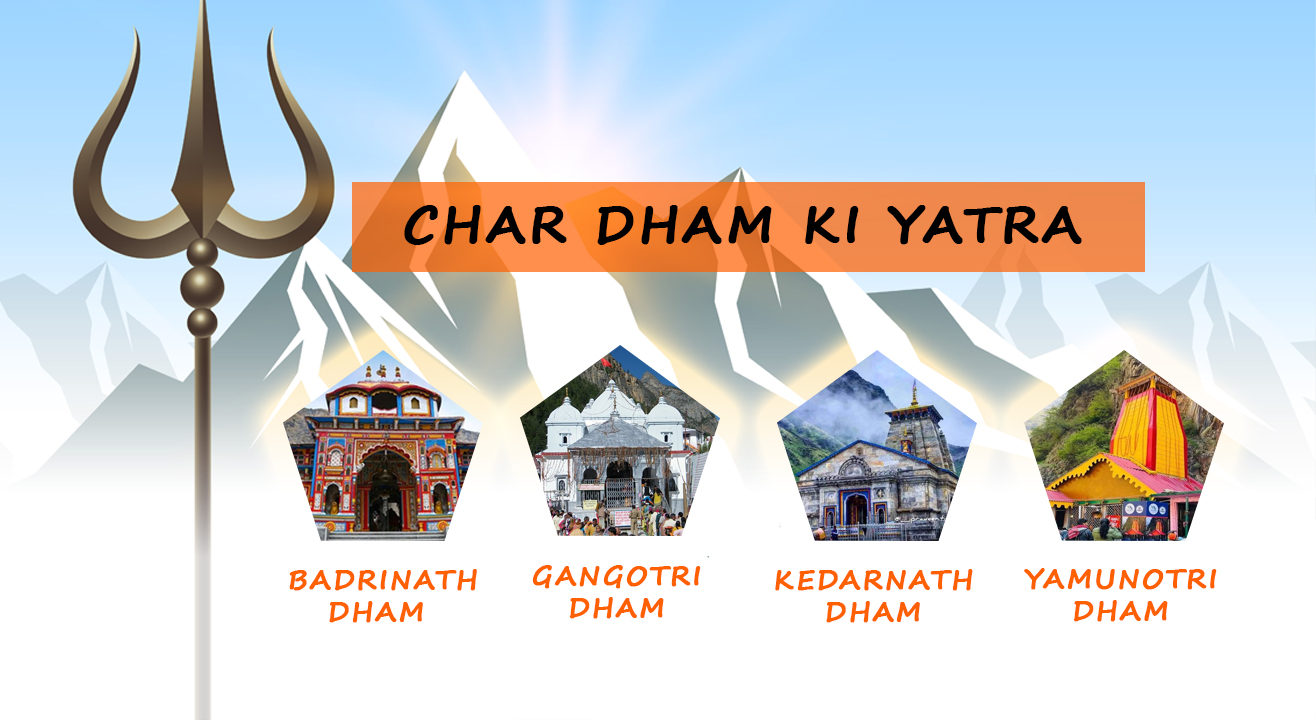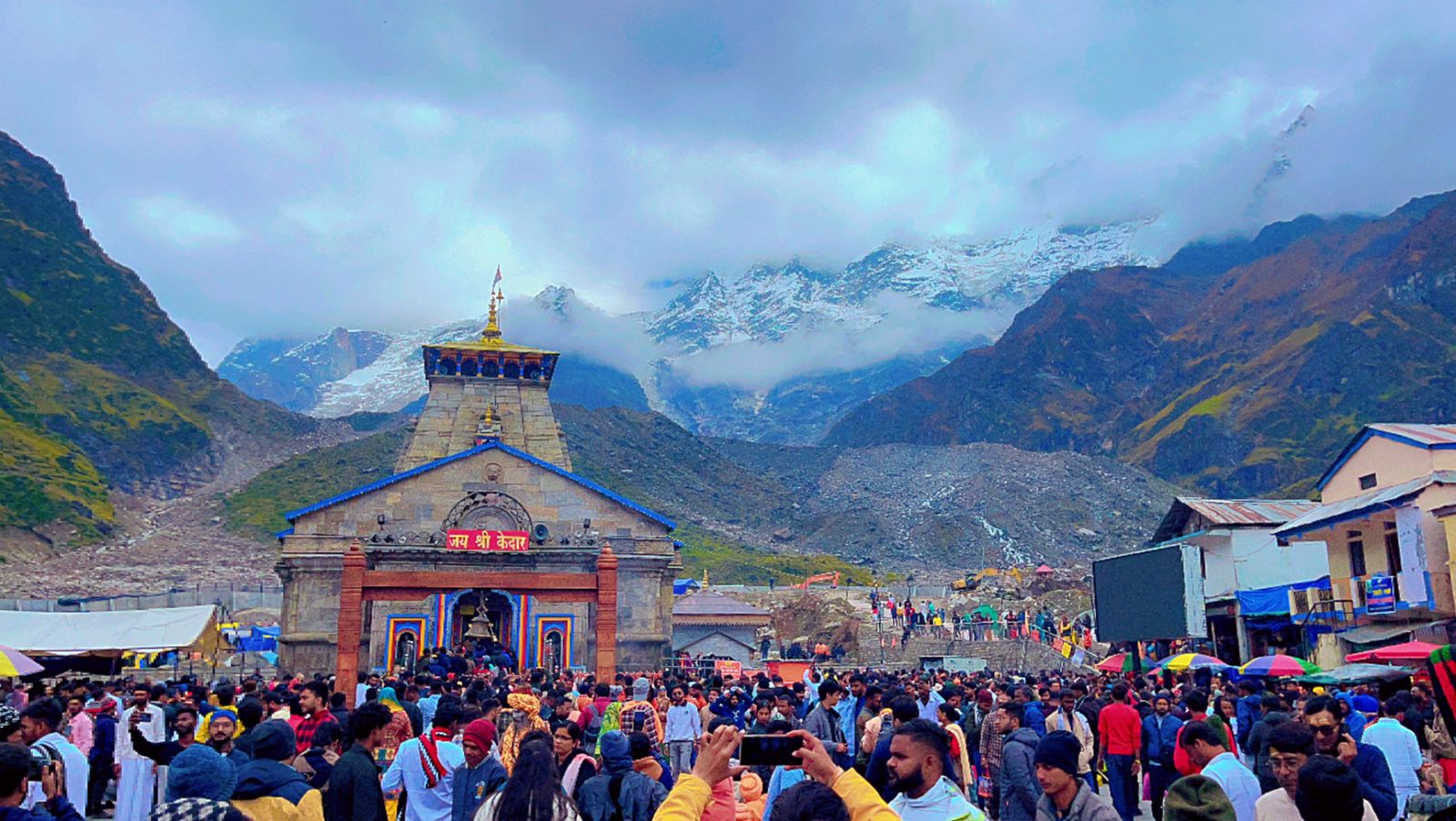
Nestled amidst the majestic Himalayan peaks, Kedarnath Jyotirlinga stands as a testimony to divine grace and devotion. It is believed to be one of the twelve Jyotirlingas, which are the embodiment of Lord Shiva’s cosmic light. The shrine is located in the Rudraprayag district of Uttarakhand, India, at an elevation of approximately 3,583 meters (11,755 feet) above sea level.
The Significance of Kedarnath Temple Jyotirlinga
Kedarnath Jyotirlinga holds immense significance in Hindu mythology and spirituality. It is believed to be the place where Lord Shiva absolved Pandavas from their sins after the great Kurukshetra war in the epic Mahabharata. The Jyotirlinga represents the infinite, all-pervading formless energy of Lord Shiva, and worshipping it is believed to bestow blessings, liberation, and spiritual enlightenment upon devotees.
The temple complex of Kedarnath is also one of the Char Dham pilgrimage sites, which holds great importance for devout Hindus. It is believed that undertaking a pilgrimage to Kedarnath, along with Yamunotri, Gangotri, and Badrinath, cleanses the soul and leads to salvation.
The Names ofthe 12 Jyotirlingas of Lord Shiva
-
Somnath Jyotirlinga– Gir Somnath in Gujarat
-
Nageshwar Jyotirlinga– Daarukavanam in Gujarat
-
Bhimashankar Jyotirlinga– Pune in Maharashtra
-
Trimbakeshwar Jyotirlinga– Nashik in Maharashtra
-
Grishneshwar Jyotirlinga– Aurangabad in Maharashtra
-
Baba Vaidyanath Jyotirlinga– Deoghar in Jharkhand
-
Mahakaleshwar Jyotirlinga– Ujjain in Madhya Pradesh
-
Omkareshwar Jyotirlinga– Khandwa in Madhya Pradesh
-
Kashi Vishwanath Jyotirlinga– Varanasi in Uttar Pradesh
-
Kedarnath Jyotirlinga– Kedarnath in Uttarakhand
-
Rameshwaram Jyotirlinga– Rameshwaram Island in Tamil Nadu
-
Mallikarjuna Jyotirlinga– Srisailam in Andhra Pradesh
Images of Kedarnath Temple
Timings of Kedarnath Temple Jyotirlinga
To pay homage and seek the blessings of Lord Shiva at Kedarnath Jyotirlinga, devotees need to be aware of the temple timings. The temple generally opens in the early morning and closes in the evening. However, it is advisable to check the specific timings before planning your visit, as they may vary depending on the season and special occasions.
In addition to regular darshan, the temple also conducts various rituals and ceremonies throughout the day, including morning and evening aarti. These rituals provide devotees with an opportunity to witness the divine grace and experience a deeper connection with Lord Shiva.
History of Kedarnath Temple Jyotirlinga
The history of Kedarnath Jyotirlinga dates back thousands of years, with references found in ancient scriptures and Puranas. According to Hindu mythology, the Pandavas, after winning the battle of Kurukshetra, sought Lord Shiva’s forgiveness for their sins of killing their own kin. Lord Shiva eluded them and took refuge in Kedarnath, disguised as a bull. When the Pandavas found Lord Shiva, he disappeared into the ground, leaving behind his hump.
The temple at Kedarnath is believed to have been built by Adi Shankaracharya, a renowned philosopher and saint, in the 8th century AD. Over the centuries, the temple has undergone several renovations and restorations to preserve its sanctity and architectural grandeur.
Image and Symbolism of Kedarnath Temple Jyotirlinga
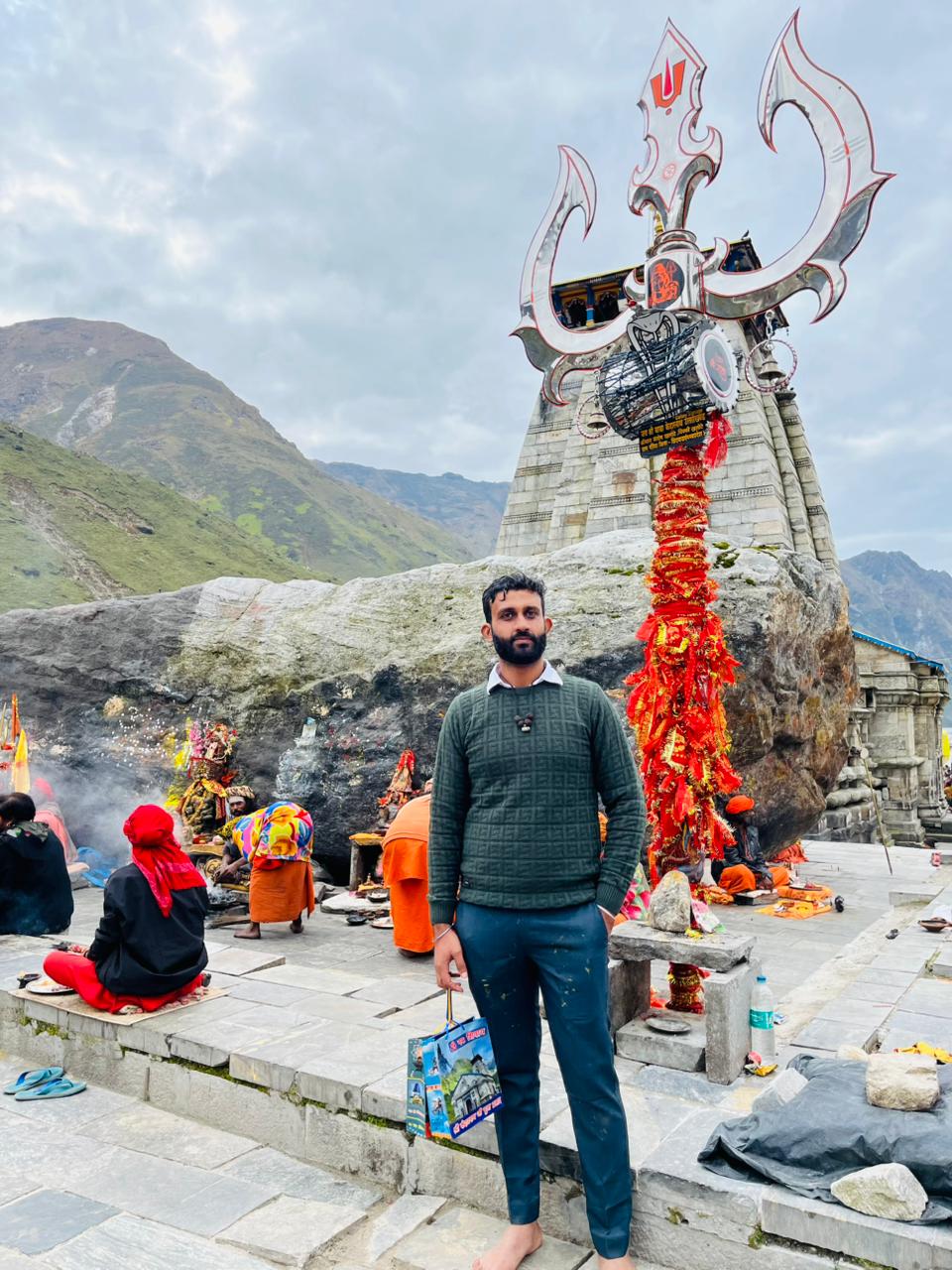
The image of Lord Kedarnath represents Lord Shiva in his meditative and eternal form. The presiding deity is a naturally formed rock, known as the “Kedareshwar,” which is worshipped as the Jyotirlinga. The rock formation resembles the hump of a bull, symbolizing Lord Shiva in his Rudra (ferocious) aspect.
The sacred Jyotirlinga is adorned with various ornaments and sacred fabrics during special occasions and festivals. Devotees offer prayers, flowers, and sacred water to seek blessings and experience spiritual transcendence in the presence of Lord Shiva.
The Story of Kedarnath Temple Jyotirlinga
The story of Kedarnath Jyotirlinga is intertwined with the ancient Hindu epic, Mahabharata. After the Kurukshetra war, the Pandavas felt remorse for their actions and sought redemption for the sins committed during the battle. To seek forgiveness from Lord Shiva, they embarked on a pilgrimage in search of him.
When the Pandavas reached the Himalayas, Lord Shiva took the form of a bull and tried to elude them. But Bhima, one of the Pandava brothers, recognized Lord Shiva and caught hold of him by grabbing his tail. However, Lord Shiva disappeared into the ground, leaving behind his hump, which is worshipped as the Jyotirlinga at Kedarnath.
The temple of Kedarnath stands as a reminder of the divine presence and the significance of seeking forgiveness, redemption, and spiritual awakening.
Location of Kedarnath Temple Jyotirlinga
Kedarnath Jyotirlinga is located in the breathtakingly beautiful surroundings of the Garhwal Himalayan range in Uttarakhand, India. Situated near the Mandakini River, the temple is nestled amidst snow-capped peaks, lush green valleys, and serene landscapes. The divine aura of the place, combined with its natural beauty, creates an atmosphere of tranquility and spirituality.
To reach Kedarnath, devotees need to undertake a trek of approximately 16 km from Gaurikund, the base camp. The trek is known for its challenging terrain, but it offers a remarkable spiritual journey amidst the picturesque mountains. Helicopter services are also available for those who prefer a faster mode of transportation.
How to Reach Kedarnath Jyotirlinga Temple
Kedarnath Jyotirlinga Temple, nestled in the Himalayas, is a sacred pilgrimage site for devotees of Lord Shiva. To reach this divine abode, follow the guide below:
By Air:
The nearest airport to Kedarnath is Jolly Grant Airport in Dehradun, Uttarakhand. From the airport, you can hire a taxi or take a bus to reach the town of Guptkashi or directly to Gaurikund, the base camp for the Kedarnath trek.
By Rail:
The closest railway station to Kedarnath is Rishikesh Railway Station, approximately 216 kilometres away. From Rishikesh, you can hire a taxi or take a bus to reach Gaurikund.
By Road:
- From Delhi: You can take a direct bus from Delhi to Kedarnath or drive to Rishikesh and then proceed to Gaurikund by road.
- From Haridwar: Buses and taxis are available from Haridwar to Gaurikund.
- From Dehradun: You can hire a taxi or take a bus from Dehradun to reach Gaurikund.
Trekking Route:
The final leg of the journey to Kedarnath Jyotirlinga involves a trek of approximately 16 KM from Gaurikund. The well-defined trekking path takes you through picturesque landscapes and offers breathtaking views of the surrounding mountains. Ponies and palanquins are available for those who prefer assistance during the trek.
Note:
- It is advisable to check weather conditions and road accessibility before planning your trip, especially during the winter months.
- Carry essential items such as warm clothing, comfortable footwear, water, snacks, and necessary medication during the trek.
- Respect the environment and local customs during your journey.
Reaching Kedarnath Jyotirlinga Temple requires a combination of air, rail, and road travel followed by a trek. The spiritual journey to this sacred destination amidst the majestic Himalayas is an experience that enriches the soul and deepens one’s connection with Lord Shiva.
Places to Visit near Kedarnath Temple

The region surrounding Kedarnath Jyotirlinga Temple offers a plethora of natural beauty and spiritual sites. Here are some notable places to visit near Kedarnath:
- Gaurikund: Gaurikund, located at the base of the Kedarnath trek, is a significant pilgrimage site. It is believed to be the place where Goddess Parvati meditated to win Lord Shiva’s affection.
- Chorabari Tal (Gandhi Sarovar): Situated approximately 3 kilometers from Kedarnath, Chorabari Tal is a pristine lake fed by glacial waters. It is a scenic spot known for its breathtaking views and tranquil surroundings.
- Vasuki Tal: Located at an altitude of 4,150 meters, Vasuki Tal is a high-altitude lake known for its picturesque beauty. It is a popular trekking destination for adventure enthusiasts.
- Triyuginarayan Temple: This ancient temple, located around 25 kilometers from Kedarnath, holds great significance in Hindu mythology. It is believed to be the place where Lord Shiva and Goddess Parvati got married.
- Trijuginarayan Village: The village of Trijuginarayan is known for its serene ambiance and beautiful landscapes. It offers a peaceful retreat for visitors seeking solace and tranquility.
- Sonprayag: Situated at the confluence of rivers Basuki and Mandakini, Sonprayag is a scenic spot renowned for its natural beauty. It holds religious significance and is an ideal place for nature lovers.
- Kalimath: Located around 23 kilometers from Guptkashi, Kalimath is a sacred shrine dedicated to Goddess Kali. It is surrounded by majestic mountains and offers breathtaking panoramic views.
- Ukhimath: Ukhimath is a small town known for its ancient temples and natural beauty. It is the winter seat of Lord Kedarnath and holds religious importance.
- Deoria Tal: Situated at an altitude of 2,438 meters, Deoria Tal is a pristine lake surrounded by lush green meadows. It offers stunning reflections of the surrounding mountains and is a haven for nature enthusiasts.
- Chopta: Known as the “Mini Switzerland of Uttarakhand,” Chopta is a picturesque hill station and the starting point for the trek to Tungnath Temple. It offers panoramic views of snow-capped peaks and is a paradise for trekkers.
Exploring these nearby attractions enhances the overall spiritual and natural experience of visiting Kedarnath Jyotirlinga. Each place has its unique charm, captivating visitors with its beauty and serene ambiance.
Best Time to Visit Kedarnath Temple
The best time to visit Kedarnath Jyotirlinga is during the summer and autumn seasons when the weather is pleasant and favorable for travel and pilgrimage. Here are the details of the best time to plan your visit:
1. Summer (May to June): The summer season is considered the peak time to visit Kedarnath Jyotirlinga. The weather during these months is cool and pleasant, with temperatures ranging between 15°C to 30°C (59°F to 86°F) during the day. The snow starts to melt, making the trekking paths more accessible. It is an ideal time for devotees and trekkers to embark on the spiritual journey.
2. Autumn (September to October): Autumn is another favorable season to visit Kedarnath Jyotirlinga. During this time, the weather remains pleasant with temperatures ranging from 10°C to 25°C (50°F to 77°F) during the day. The monsoon season recedes, and the region is adorned with lush greenery. The clear skies and mild temperatures make it an ideal time for darshan and exploring the surrounding natural beauty.
It is important to note that Kedarnath Jyotirlinga is located in the high Himalayas, and the weather conditions can be unpredictable. It is advisable to check the weather forecast and road conditions before planning your visit. The temple remains closed during the winter months from November to April due to heavy snowfall and extreme weather conditions.
Avoid visiting during the monsoon season (July to August) as the region receives heavy rainfall, increasing the risk of landslides and trekking difficulties. However, if you prefer a quieter and less crowded pilgrimage experience, you may consider visiting during the shoulder seasons.
Ultimately, the best time to visit Kedarnath Jyotirlinga depends on personal preferences and convenience. It is recommended to plan your trip in advance, considering the weather conditions and the spiritual significance of the chosen time.
Dharamshala (guesthouses) near Kedarnath Jyotirlinga Temple
When visiting Kedarnath Jyotirlinga Temple, pilgrims have the option to stay in nearby Dharamshalas (guesthouses) that provide basic accommodation facilities. These Dharamshalas offer a comfortable and convenient stay for devotees undertaking the spiritual journey. Here are some notable Dharamshalas near Kedarnath Jyotirlinga Temple:
- Kedarnath Dharamshala: Located in close proximity to the temple, Kedarnath Dharamshala offers simple and clean rooms for pilgrims. The rooms are equipped with essential amenities like beds, blankets, and basic furniture. The Dharamshala also provides hygienic food for the guests.
- Gaurikund Dharamshala: Situated at the base camp of the Kedarnath trek, Gaurikund Dharamshala is a convenient option for pilgrims starting their journey. It provides comfortable rooms, clean washrooms, and basic facilities to ensure a pleasant stay for visitors.
- Sonprayag Dharamshala: Located near the confluence of the Basuki and Mandakini rivers, Sonprayag Dharamshala offers decent accommodation for devotees. The Dharamshala provides clean rooms, hot water facilities, and vegetarian meals.
- Rampur Dharamshala: Situated in the Rampur village, this Dharamshala is a peaceful place to stay near Kedarnath. It offers basic accommodation facilities and serves vegetarian meals to the guests.
- Guptkashi Dharamshala: Guptkashi, a town located on the route to Kedarnath, has several Dharamshalas that provide comfortable stay options. These Dharamshalas offer clean rooms, basic amenities, and vegetarian meals for pilgrims.
It is advisable to book Dharamshala accommodation in advance, especially during the peak pilgrimage season, to ensure a hassle-free stay. While the facilities provided in these Dharamshalas may be basic, they offer a peaceful environment for devotees to rest and rejuvenate during their spiritual journey to Kedarnath Jyotirlinga Temple.
Restaurants near Kedarnath Jyotirlinga Temple
While visiting Kedarnath Jyotirlinga Temple, pilgrims have the option to dine at nearby restaurants that serve a variety of vegetarian meals. These restaurants offer nourishing food to satisfy the hunger of devotees after their spiritual journey.
Here are some popular restaurants near Kedarnath Jyotirlinga Temple:
- Kedarnath Bhojanalaya: Located in close proximity to the temple, Kedarnath Bhojanalaya is a popular restaurant serving vegetarian meals. It offers a simple menu with a selection of North Indian and South Indian dishes, along with traditional Kumaoni cuisine. The restaurant maintains hygiene standards and provides a comfortable dining experience.
- Gaurikund Restaurant: Situated at the base camp of the Kedarnath trek, Gaurikund Restaurant is a convenient stop for pilgrims. It serves delicious vegetarian food, including Indian thalis, roti-sabzi, and snacks. The restaurant also offers tea, coffee, and refreshments for visitors.
- Sonprayag Food Court: Located near the confluence of the Basuki and Mandakini rivers, Sonprayag Food Court is a popular dining spot for pilgrims. It offers a range of vegetarian dishes, including Indian, Chinese, and local cuisines. The food court provides a pleasant ambiance and quick service.
- Rampur Restaurant: Situated in the Rampur village, Rampur Restaurant is known for its delectable vegetarian meals. It serves a variety of dishes, including North Indian, South Indian, and Gujarati cuisines. The restaurant ensures cleanliness and quality in its food preparations.
- Guptkashi Food Joints: Guptkashi, a town on the way to Kedarnath, has several food joints that cater to the dietary needs of pilgrims. These food joints offer vegetarian meals, snacks, and beverages to energize visitors during their journey.
It is important to note that the availability of restaurants and food options may vary depending on the season and rush of pilgrims. Additionally, due to the remote location, the menu choices may be limited. However, these restaurants strive to provide wholesome and nourishing food to ensure pilgrims’ well-being during their visit to Kedarnath Jyotirlinga Temple.
Festivals Celebrated at Kedarnath Jyotirlinga Temple
Kedarnath Jyotirlinga Temple is a site of immense religious significance and is known for its vibrant and festive atmosphere. The temple celebrates various festivals throughout the year, attracting a multitude of devotees.
Here are some of the prominent festivals celebrated at Kedarnath Jyotirlinga Temple:
- Maha Shivaratri: Maha Shivaratri is one of the most significant festivals celebrated at Kedarnath Jyotirlinga Temple. Devotees throng the temple in large numbers to offer prayers and seek blessings from Lord Shiva. Special rituals, including elaborate abhishekams (holy bath) and night-long vigils, are conducted to honor Lord Shiva.
- Char Dham Yatra: The Char Dham Yatra, which includes Kedarnath Jyotirlinga Temple along with Badrinath, Gangotri, and Yamunotri, is a renowned pilgrimage circuit in Uttarakhand. Devotees undertake this arduous journey to seek divine blessings and spiritual fulfillment. The yatra commences during the summer months and attracts devotees from all over the country.
- Raksha Bandhan: Raksha Bandhan, a festival celebrating the bond between brothers and sisters, holds significance at Kedarnath Jyotirlinga Temple. Devotees tie sacred threads (rakhi) to the Jyotirlinga as a symbol of protection and seek blessings for their loved ones.
- Krishna Janmashtami: Krishna Janmashtami, the birth anniversary of Lord Krishna, is celebrated with great enthusiasm at Kedarnath Jyotirlinga Temple. Devotees participate in bhajans (devotional songs), recite Krishna’s leelas (divine acts), and offer prayers to Lord Krishna.
- Navratri and Durga Puja: Navratri, a nine-night festival dedicated to the worship of Goddess Durga, is celebrated with fervor at Kedarnath Jyotirlinga Temple. The temple premises witness special ceremonies, devotional performances, and processions during this auspicious period.
- Kedarnath Temple Anniversary: The anniversary of the temple’s establishment is an occasion of grand celebration. Devotees gather to commemorate the rich history and significance of the temple. Special rituals, cultural programs, and devotional activities mark this significant day.
Apart from these major festivals, various other religious and cultural events take place throughout the year, adding to the vibrancy and spiritual aura of Kedarnath Jyotirlinga Temple. These festivals provide an opportunity for devotees to immerse themselves in devotion, experience divine grace, and connect with the spiritual heritage of the temple.
Conclusion
Kedarnath Jyotirlinga holds a special place in the hearts of devotees, attracting millions of pilgrims every year. Its mystical aura, combined with the awe-inspiring natural beauty of the Himalayas, creates an unforgettable spiritual experience. The temple’s rich history, deep-rooted mythology, and divine energy make it a revered destination for seekers of spiritual solace and enlightenment.
As you embark on a pilgrimage to Kedarnath Jyotirlinga, allow yourself to be immersed in the divine vibrations and embrace the profound blessings that Lord Shiva bestows upon his devotees.
FAQs About Kedarnath Temple
What are the timings of the Kedarnath temple for darshan?
The Kedarnath temple opens in the morning and closes in the evening for darshan. The exact timings may vary depending on the season and prevailing conditions. It is advisable to check with the temple authorities or local guides for the updated darshan timings.
Why is Kedarnath closed for 6 months?
Which month is best for Kedarnath trip?
The best time to visit Kedarnath is during the summer and autumn seasons, which are from May to June and September to October. During these months, the weather is pleasant, and the trekking routes are relatively accessible. It is advisable to avoid the monsoon season (July to August) due to heavy rainfall and the winter season (November to April) due to extreme cold and snowfall.
How much does a Kedarnath trip cost?
The cost of a Kedarnath trip can vary depending on various factors such as mode of transportation, accommodation, food, and additional expenses. It is advisable to plan your budget considering these aspects. The cost can range from moderate to high, depending on the choices you make during your journey.
How can I register for Kedarnath Yatra 2025?
The registration process for the Kedarnath Yatra 2025 may vary depending on the rules and regulations set by the local authorities and the government. It is advisable to visit the official website or contact the designated authorities to get the latest information on the registration process and any necessary permits required for the yatra.
What are the timings of the Kedarnath Yatra?
The timings for the Kedarnath Yatra can vary depending on the prevailing conditions and the rules set by the authorities. It is advisable to check with the local authorities or tour operators for the updated timings and any specific guidelines to be followed during the yatra.
What is the right time to visit Kedarnath Temple?
The right time to visit Kedarnath Temple is during the summer and autumn seasons, which are from May to June and September to October. These months offer pleasant weather and favorable trekking conditions. However, it is essential to check the weather forecast and road conditions before planning your visit, as the region is prone to sudden weather changes.
How can I reach Kedarnath Jyotirlinga? What are the transportation options?
To reach Kedarnath Jyotirlinga, you need to first reach the town of Gaurikund, which is the base camp for the Kedarnath trek. From there, you can either trek for approximately 16 kilometers or avail of helicopter services, which are available from Phata or Guptkashi. Helicopter services provide a quicker mode of transportation. It is advisable to check the availability and make necessary arrangements in advance.
Is photography allowed inside the temple premises?
As per the guidelines set by the temple authorities, photography is generally not allowed inside the temple premises. It is advised to respect the sanctity of the temple and follow the rules and regulations in place. However, you may be allowed to capture photographs in designated areas outside the temple premises.
Are there any nearby attractions to explore along with Kedarnath Jyotirlinga?
Yes, there are several nearby attractions to explore along with Kedarnath Jyotirlinga. Some notable places include Triyuginarayan Temple, Gandhi Sarovar (Chorabari Tal), Vasuki Tal, Sonprayag, Guptkashi, and Rudraprayag. These attractions offer breathtaking natural beauty and spiritual significance, adding to the overall experience of the pilgrimage.

